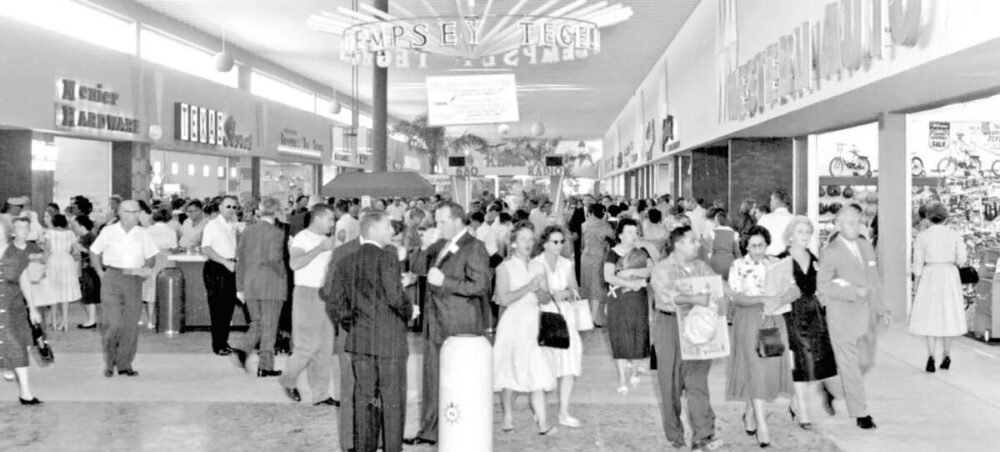
Welcome to another edition of Meet the Team! This month, we would like you to meet Nathan Kiecker. Nathan is an Architectural Designer and has been a part of the Aria Group team since 2019. Recently, Nathan’s focus has been on several Shake Shack projects around the U.S. and his technical talents have been instrumental to several other sports entertainment venues like Topgolf and the Henrico Sports Complex. Rounding out his hospitality experience, Nathan is also on the team that designed three new food & beverage spaces within Chicago’s Museum of Science and Industry. Continue reading to learn more about Nathan!
What project are you most proud of since being at Aria Group? That would be my first project ever: Shake Shack San Francisco Centre. It was a small interior buildout in the Westfield Mall but it taught me the detailed intricacies that smaller projects require when designing in an existing space. I would liken it to mastering a game of Tetris. Being a part of the process was definitely very rewarding specifically in detailing and coordinating an angular design.
Where did you grow up? I grew up, and still live, in Berwyn, Illinois. Berwyn is 10 minutes south of Oak Park where Aria is located so I have been familiar with the area and surroundings all my life. It is really nice being close by our office.
What did you want to be when you grew up and why? Since childhood, I have always wanted to be an architect. It may sound cliché, but being introduced and experiencing Frank Lloyd Wright’s residential work along with his home and studio—just minutes from my own home—was very influential. I took that direction and passion and have built my career toward that goal.
How many siblings do you have and are they anything like you? I have two older sisters Nicole (the oldest) and Nora (Middle) which makes me the baby. A fun fact is our names start with the letter N, and I would say all three of us have design-orientated minds as do our parents, who are both graphic designers. We all followed in their footsteps.
 Nathan and his two older sisters all followed in their parents footsteps with design oriented careers.
Nathan and his two older sisters all followed in their parents footsteps with design oriented careers.
What is something you get overly competitive about and why? Anything sports-related, definitely golf. If I wanted to be completely honest though, I’m competitive when it comes to anything that involves two individuals and an end goal of winning. Being competitive is a personal driver for me but when I’m working with my team – I want my team to be successful first and foremost.
 Nathan is always ready for a competitive game of golf!
Nathan is always ready for a competitive game of golf!
If you could only eat one meal for the rest of your life, what would it be and why? Pasta! I have eaten it so much that now I can make my own sauce from scratch. It’s just one of those easy quick meals that can be made anytime.
What’s the last TV show you binge-watched? Ozark. Season 4, Part 1.
What’s your current favorite TV show? Peacemaker! If you have not seen, or heard of this, do yourself a huge favor and have a blast. Thank me later.
What is in the trunk of your car right now? My golf clubs. I’m always prepared for a round with the boys, weather permitting of course. But then again, that is what Topgolf is for!
What is something most people don’t know about you? I collect sneakers. #Sneakerhead. I have really stepped up my game in the last 5 years. I usually wear beaters during the winter, but when the weather warms up be on the lookout for the heat!
Do you have a favorite travel story? So this is not one of my best stories, but it’s definitely one I’ll always remember. When I was in college I decided to wait in line for the new iPhone (at the time it was the iPhone 6). In-store purchasing started at 6am on a Saturday morning at this particular mall which was roughly 15 miles away from college. I had the bright idea of biking there to be one of the first to purchase. So I left and headed out around 8pm the evening before. Since this part of Michigan did not have many sidewalks or street lights, I had to bike up and down hilly roads overnight holding a flashlight in one hand and cars racing past me. After 2 hours of biking I arrived. Following several cups of coffee at a nearby Denny’s, I headed over to the mall to jump in line. It was incredible how many people rushed in all at once—many of them serial early adopters who always flood Apple stores for the next upgrade. The experience was chaos! Pushing, shoving— pure CHAOS! Even an ambulance arrived to help with injuries. When I finally made it to the front of the line, I learned that I needed my parent to verify the account information. The crazy adventure was all for nothing. Ever since, I happily just order online!
Check out other editions of Meet the Team on our Blog!
Reinventing the American Mall

 North Star Mall Opening Day 1960 (Express News Archives)
North Star Mall Opening Day 1960 (Express News Archives)
Take a drive down the business highway in most mid-size towns, and odds are that you will inevitably pass by one of the great relics of a bygone era in American culture. The indoor mall was once the epicenter of shopping convenience and consumer capitalism in the 70’s, 80’s, and 90’s. Check out this video of the Richfield Edina shopping mall from 1956 — a flashback to this era and one of the earliest malls in the United States. Southdale 1956 – Richfield Edina Shopping Mall
Today many indoor malls are in a state of suspended animation – a gawky, mammoth lying dormant as the pulse of shopping has run back to main street, lifestyle centers, and of course online retail. Many of the flagship brands that iconized the mall era have long since flown the coop for more lucrative pastures, and the bare bones of what remains – empty shops, food courts, theatres, arcades, plazas, and stalls – sit idly awaiting reinvention.
 Photos of Mall exteriors (Abandoned Mall photos – Seph Lawless/Getty Images)
Photos of Mall exteriors (Abandoned Mall photos – Seph Lawless/Getty Images)
It doesn’t take too much digging to unearth why: simply put, the existing mall format does not meet the more holistic needs of today’s generation. This may be most notable when one compares the typical mall configuration, which relies almost entirely on the foot traffic generated by big-box stores, to the rising trend for more integrated lifestyle design, particularly the “live, work, shop, play” format. When you lump in the growing desire for walkability and sustainable urban design, it becomes very easy to scrutinize the visual, and often visceral, reaction that malls evoke; the far out, windowless behemoth sized complexes, which often float in a sea of parking lots, turn customers away through its lack of appeal and accommodation. In short, if indoor malls want to continue to be relevant, they must confront the changing epoch in front of them and seriously commit to an identity make over.
The paradox is that malls are well-practiced in reinventing themselves. New stores, kiosks, seasonal displays, and even small fast-food retailers flip in and out of plug-and-fill spaces all the time. This highlights one of the great silver-linings for malls looking to adapt: the archetype of mall spaces makes them extremely changeable by design. The more demanding work lies in integrating atypical programs to the standard mall framework, such as housing, entertainment, and recreation. At such a large scale, the role of the designers and architects in this realm cannot be understated; planners and developers must become skilled alchemists who balance the correct blend of programs and utilities to address the morphing needs of future dwellers and patrons, while also keeping costs and existing programs in check.
 Case Study: Stratford Square Mall + Aria Group
Case Study: Stratford Square Mall + Aria Group
At Aria Group, our team approached this endeavor by applying our knowledge and long standing history of experiential design and thinking about how we can alter the framework of malls to meet the needs of today. In particular, our team developed a number of proposed interventions for the Stratford Square Mall in Bloomingdale, IL, which like many malls has shared in the saga of continual decline in recent years. Regarding the strategy for revitalization, Principal Frank Cavanaugh wrote, “ the key strategy we see in giving new life to malls is turning them inside out. Carving out and demolishing underutilized gross leasable area (GLA) to create more elevated exterior tenant visibility and enhanced guest experiences”.
 Proposed Plan Concept- Southwest Entry, Stratford Square Mall
Proposed Plan Concept- Southwest Entry, Stratford Square Mall
This includes introducing lively restaurant concepts that perforate the building’s envelope, especially where they might enrichen existing mall entrances, and adding a mix of other lifestyle businesses like spas, health clubs, grocers, and medical offices. Similarly, exterior spaces and parking lots can be converted to event lawns, seasonal skating rinks, beer gardens, and other mixable entertainment spaces to bring more meaningful and attractive entertainment to the surface of the mall.
 Stratford Square Mall Southwest Entry – Before & After
Stratford Square Mall Southwest Entry – Before & After
The mission to diversify the mall’s retail base goes beyond just a facelift however. The proposition also includes the potential to infuse multi-unit residential and office spaces into the existing complex, turning the typical weekend shopping center into a vibrant community of workers and neighbors. This contemporary pairing of program is akin to the complexion of the traditional town center, where shopping is just an element in the macro-experience of everyday life. In fact, it is precisely the varied assortment of experiences that we believe will make Stratford Square such a desirable place to live, and bring patrons back to visit time and time again.
 Stratford Square Mall – Medical & Residential Site Plan Studies
Stratford Square Mall – Medical & Residential Site Plan Studies
To investigate the potential design possibilities in more depth, Aria Group also conducted a case study of a revival of the Charlestown Mall in St. Charles, Illinois. Check out our next post where we share our exploration into the merger of programs and the spatial opportunities that could re-define the future of America’s malls.








